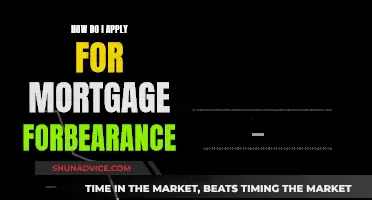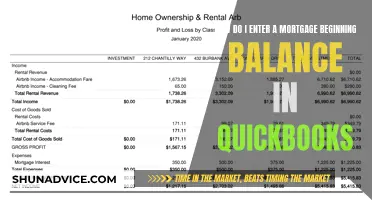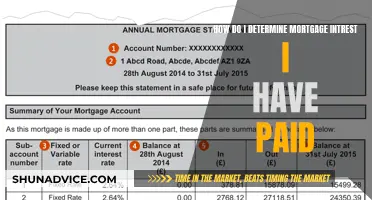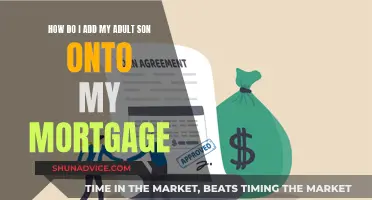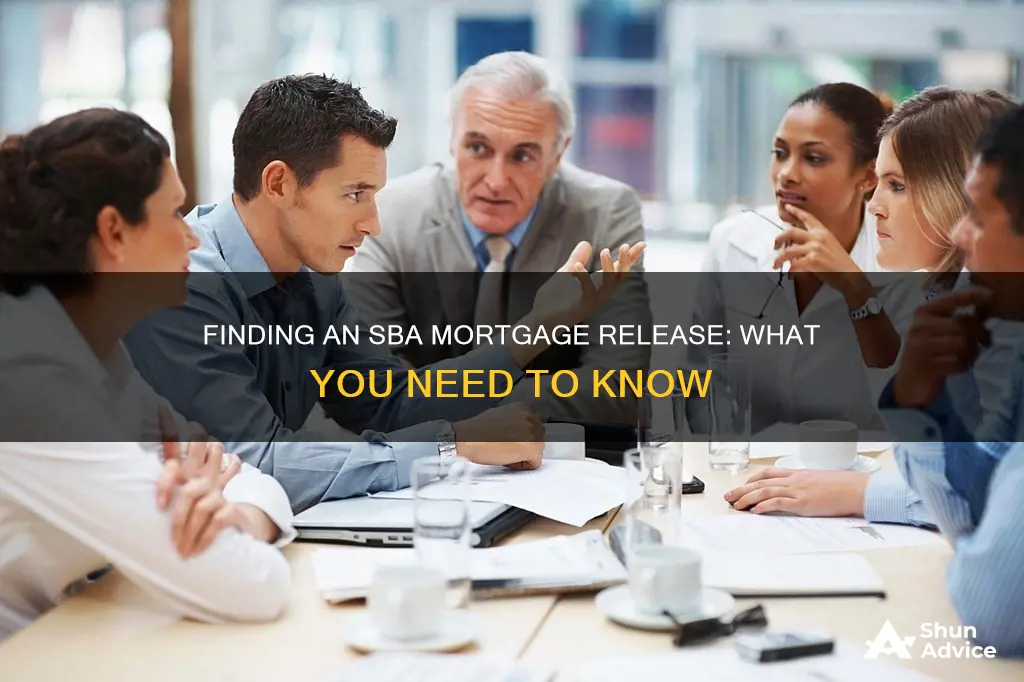
The U.S. Small Business Administration (SBA) helps small businesses secure funding by setting guidelines for loans and reducing lender risk. These SBA-backed loans are offered by intermediary lenders and can be used for most business purposes. The SBA also provides direct loans to businesses and homeowners recovering from a disaster. The SBA is willing to release a mortgage/lien so that the owner can sell or refinance under the right circumstances. This article will explore how to find a release of mortgage from the SBA.
What You'll Learn

Removing an SBA lien or mortgage on your home
If you have an SBA lien on your home, it is possible to have it removed under the right circumstances. Firstly, it's important to note that the SBA will not release a lien on your home even if you have been discharged from personal bankruptcy, especially if there is equity in your home. In this case, the bank must voluntarily agree to release their mortgage.
The SBA will be willing to release a mortgage/lien if the owner needs to sell or refinance the property. This requires cooperation and commitment from the borrower, who must not receive any sales or refinance consideration. All proceeds must be distributed in order of priority. The best path to removal is often to make an Offer In Compromise, which resolves the SBA subordinate lien for a fraction of the cost, and once that is settled, the lien will be released, and the offer value of the property returned to the owner.
If you are not personally liable for the debt, an OIC is not needed. SBA preferred lenders can release collateral without the need for SBA approval. If your lender claims they need SBA approval, find out if they are a preferred lender.
In most cases, you will need to negotiate with your original lender, not the SBA, to get an SBA loan release. You will need to coordinate with whoever is servicing the file to return it to the originating bank. If the SBA holds the loan, they can usually do this without much difficulty. If the loan is with the Treasury, however, it may be more challenging to get the required approval.
If your business defaults on the SBA loan, the lender bank must liquidate all collateral with "Recoverable Value". If the Recoverable Value of an individual parcel is $10,000 or more, it must be liquidated unless there is a documented, compelling reason not to. If the bank holds an SBA lien on your residence, you may face the possibility of foreclosure.
If you are facing foreclosure, the SBA dictates that you can save your home, but you will have to pay to do so. The amount of consideration received must be approximately equal to or greater than the "Recoverable Value" of the collateral, and the release of the lien must not jeopardize the ability to maximize recovery on the loan.
Deleting Wells Fargo Mortgage Autopay: A Step-by-Step Guide
You may want to see also

Negotiating with your lender
Understanding the Dynamics: Recognize that the SBA is typically willing to release a mortgage or lien to allow the owner to sell or refinance the property under the appropriate circumstances. This flexibility exists even in cases where the SBA loan was used to acquire the property. However, it requires cooperation and commitment from the borrower, who must not directly benefit from any sales or refinance proceeds.
Engaging the Right Party: In most cases, negotiating with the original lender, not the SBA, is essential for obtaining an SBA loan release. This is because the originating lender is usually the lienholder. Ensure you coordinate with the relevant parties to manage the process effectively.
Offer in Compromise: One of the most common paths to removing an SBA lien is by making an Offer in Compromise (OIC). This approach involves resolving the SBA subordinate lien for a fraction of its value. Once the OIC is accepted and settled, the lien will be released, and the property's value will revert to the owner.
Personal Liability and Guarantees: Understanding your personal liability for the debt is crucial. If you are personally liable, submitting an OIC is often the recommended course of action. However, if you are not personally liable (for example, due to personal bankruptcy or pledging your home as a favour to a borrower), an OIC is typically not required.
Preferred Lenders: It's important to know that SBA preferred lenders have the authority to release collateral without seeking SBA approval. If your lender claims they need SBA approval, clarify whether they are indeed a preferred lender. This knowledge can streamline the process and avoid unnecessary delays.
Patience and Expertise: Negotiating a release of mortgage from the SBA can be a complex and challenging process. It often requires patience, expertise, and sometimes capital. Engaging professionals with expertise in debt resolution and SBA loan processes can be advantageous in navigating these complexities and achieving a favourable outcome.
Discharging Your Mortgage: What You Need to Know
You may want to see also

Lender requirements for SBA loans
The Small Business Administration (SBA) helps small businesses get funding by setting guidelines for loans and reducing lender risk. These SBA-backed loans make it easier for small businesses to get the funding they need.
Lenders and loan programs have unique eligibility requirements. In general, eligibility is based on what a business does to earn income, the character of its ownership, and where the business operates. Businesses must meet SBA size standards, be able to repay, and have a sound business purpose. The business must be officially registered and operate legally, be physically located and operate in the United States or its territories, and have sound credit to assure loan repayment. The requested loan should be unavailable on reasonable terms from non-government sources.
The Microloan program provides small businesses with small, short-term loans of up to $50,000 for working capital or to buy inventory, supplies, furniture, fixtures, machinery, and equipment. To participate in the Microloan program, a lender must be a private nonprofit, quasi-public, or tribally-owned entity.
For the CDC/504 loan program, a lender must have a board of directors with at least nine voting directors and have full-time professional management and a full-time professional staff.
Lenders that work with SBA provide financial assistance to small businesses through government-backed loans. SBA-guaranteed loans generally have rates and fees that are comparable to non-guaranteed loans. Some loans come with continued support to help start and run a business. Loans guaranteed by SBA range from small to large and can be used for most business purposes, including long-term fixed assets and operating capital.
For loans with a maturity of 15 years or longer, prepayment penalties apply when the borrower voluntarily prepays 25% or more of the outstanding balance of the loan within the first three years after the date of the first disbursement.
Switching Your Chase Mortgage to Semi-Monthly Payments
You may want to see also

SBA loan forgiveness
The U.S. Small Business Administration (SBA) helps small businesses get funding by setting guidelines for loans and reducing lender risk. These SBA-backed loans make it easier for small businesses to get the funding they need. The SBA only makes direct loans in the case of businesses and homeowners recovering from a declared disaster, such as the wildfires in California or Hurricanes Helene and Milton.
The SBA also offers loan forgiveness for its Paycheck Protection Program (PPP). Borrowers can apply for forgiveness any time up to five years from the date that the SBA issued the loan number. If borrowers do not apply for forgiveness within 10 months after the last day of the covered period, then PPP loan payments are no longer deferred, and borrowers will begin making loan payments to their PPP lender. Applications for forgiveness can be made through the SBA's direct forgiveness portal or directly through a lender. Each forgiveness form has unique instructions for documentation that must be submitted with the application. For example, SBA Form 3508S does not require borrowers to provide additional documentation upon forgiveness submission, but borrowers should be prepared to provide relevant documentation if requested as part of the loan review or audit processes.
In addition to PPP loan forgiveness, the SBA is willing to release a mortgage/lien under certain circumstances, such as allowing the owner to sell or refinance the property. To do this, the borrower must not receive any of the sales or refinance consideration, and all proceeds must be distributed in order of priority. One way to achieve this is by making an Offer in Compromise, which resolves the SBA subordinate lien for a fraction of the debt, after which the lien is released, and the offer value of the property is returned to the owner. It is important to note that even if you have been discharged from personal bankruptcy, you will not automatically receive an SBA lien release on your home, especially if there is equity in it. In most cases, you will need to negotiate with your original lender, not the SBA, to get an SBA loan release.
Applying for a Mortgage Freeze: What You Need to Know
You may want to see also

SBA disaster assistance
The U.S. Small Business Administration (SBA) provides disaster assistance in the form of low-interest disaster loans to help homeowners, renters, and businesses of all sizes recover from declared disasters. These loans can be used to repair or replace disaster-damaged property, including real estate, inventory, equipment, and supplies. The SBA also offers expanded funding to make improvements that prevent future damage.
To be eligible for SBA disaster assistance, you must be located in a declared disaster area and meet other eligibility criteria depending on the type of loan. For example, businesses must typically meet SBA size standards, be able to repay, and have a sound business purpose. Even those with bad credit may qualify for startup funding.
The SBA offers up to $2 million in recovery funds for businesses and nonprofits. Homeowners may apply for up to $500,000 to repair or replace their primary residence, while renters and homeowners may apply for up to $100,000 to replace personal property, including clothing, furniture, appliances, and vehicles.
In addition to SBA loans, the Federal Emergency Management Agency (FEMA) provides disaster assistance for homeowners and renters in need of repairs, temporary housing, or property replacement. This assistance covers essential home repairs, rental assistance, and other disaster-related expenses.
To apply for SBA disaster assistance, you can log in to your account on the SBA website and check for updates. You can also call the SBA's Customer Service Center at (800) 659-2955 or send an email to [email protected]. Disaster Loan Outreach Centers are available to answer questions and help individuals complete their applications.
Comparing Mortgages: What You Need to Know
You may want to see also
Frequently asked questions
If your SBA lender obtains a judgement against you, they can place a judgement lien on your personal assets, which includes your personal residence.
In most cases, you need to negotiate with your original lender and not the SBA to get an SBA loan release. You will need to coordinate with whoever is servicing the file to return it to the originating bank.
Even if you have been discharged from personal bankruptcy, you will not automatically receive an SBA lien release on your home. This is especially true if there is equity in your home. The bank must voluntarily agree to release their mortgage.
For all other payment-related inquiries, visit the "Get help" section of the "Make a payment to SBA" page. To report technical problems with Lender Match, contact [email protected]. For assistance with SBA disaster loans, please email [email protected].


